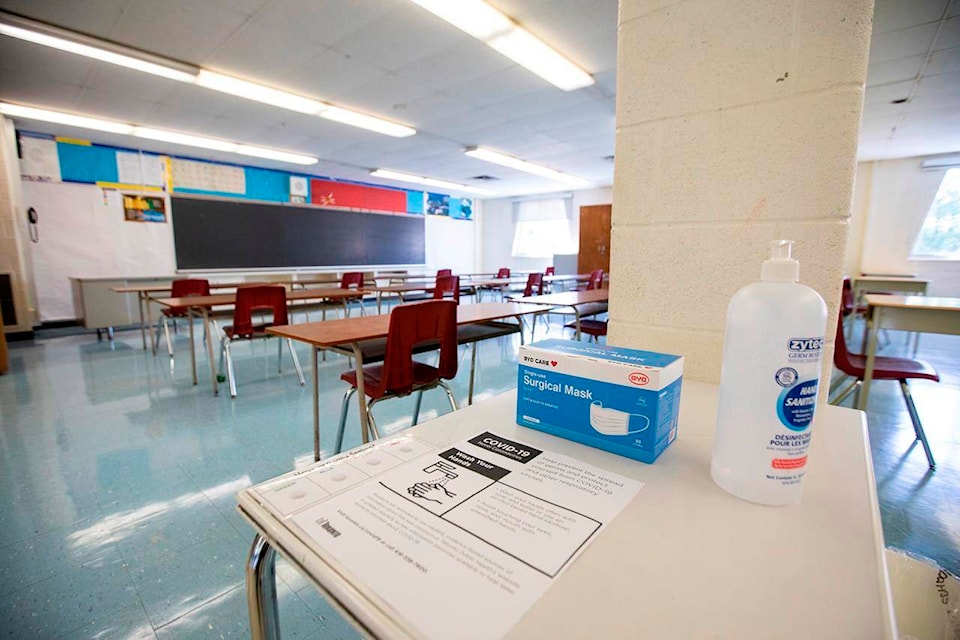New data from Fraser Health says COVID-19 transmission in Surrey schools was “limited” between January and June of this year.
The health authority released the data review Tuesday (Aug. 24) that examined 2,935 of 3,287 cases of COVID-19 reported between January and June, 2021.
But Surrey Teachers’ Association president Matt Westphal said “there are limitations” to the data, adding that it doesn’t include cases from the beginning of the year and it “may not cast an entirely accurate picture that way.”
READ ALSO: COVID outbreak forces Surrey school to close for two weeks, along with one in Delta, Nov. 14, 2020
READ ALSO: Second Surrey elementary school declares COVID-19 outbreak, closes for two weeks, Nov. 27, 2020
Before the winter break, at least two schools were shut down due to an outbreak and there were numerous classes in self-isolation. Then when students returned to school following spring break, the Surrey school district was the first to require masks for staff and students in grades 4 to 12 indoors at all times.
READ ALSO: Masks required ‘at all times’ indoors for grades 4-12 at Surrey school district, March 27, 2021
The Fraser Health report says 90 per cent of school-associated cases in Surrey “originated in households or the community, not in schools.”
However, Westphal noted that Fraser Health only considers a case to have in-school transmission if they can exclude any possible household or community spread. So if two students, who sit next to each other in class, but hang out outside of school caught the virus, it would count as outside of school, he said.
In May, a Fraser Health report was posted online that showed one-third of school-acquired cases spread into the community. The data reflected the time period when students returned to school in January until March 7.
READ ALSO: Fraser Health still unsure if 333 cases of COVID among students, teachers were acquired in school, May 12, 2021
READ ALSO: Surrey communities recording more COVID-19 cases also seeing lower vaccination rates, May 8, 2021
Of the 2,049 cases found among school staff, teachers and students from January to early March, Fraser Health considers 267 –13 per cent – to be school-acquired. Of those, 88 lead to community or household spread.
However, Fraser Health data shows there were an additional 333 cases with “suspect acquisition in school” that were not included in the 267 confirmed school acquired cases. If those cases were added to school-based infections, that would push the percentage teachers and students who caught COVID-19 at school from 13 per cent to 29 per cent, more than doubling it.
Meantime, in the January-to-June report, staff accounted for 11 per cent of cases, while students were the remaining 89 per cent, and about three per cent of the overall school population in Surrey was reported to have COVID-19 during the study period.
Westphal said that while the three per cent may seem low, some people go extremely sick, some ended up in ICU and there are long-term effects for COVID-19.
“That’s something to keep in mind,” he said. “I wouldn’t take this as a reason not to have stronger health-and-safety measures.”
With that, Westphal said he is disappointed about the Ministry of Education’s announcement that masks will only be mandatory for grades 4 to 12 and staff. Masks are recommended, or encouraged, for kindergarten to Grade 3.
READ ALSO: Masks required for Grade 4 and older in B.C. as part of return-to-school plan, Aug. 24, 2021
“We know this is a group of students who can get (COVID-19), transmit it and don’t have access to vaccines,” he said. “They really need the benefit of every protection we can give them.”
However, he said there were some positives in the announcement, including there could be different regional approaches depending on how the pandemic affects different communities.
He said that was part of the frustration last year when Surrey was incredibly hard hit during the second and third waves.
COLUMN: Localized COVID-19 data could have helped Surrey communities hit hardest, May 22, 2021
– With files from Katya Slepian
lauren.collins@surreynowleader.com
Like us on Facebook Follow us on Instagram and follow Lauren on Twitter
